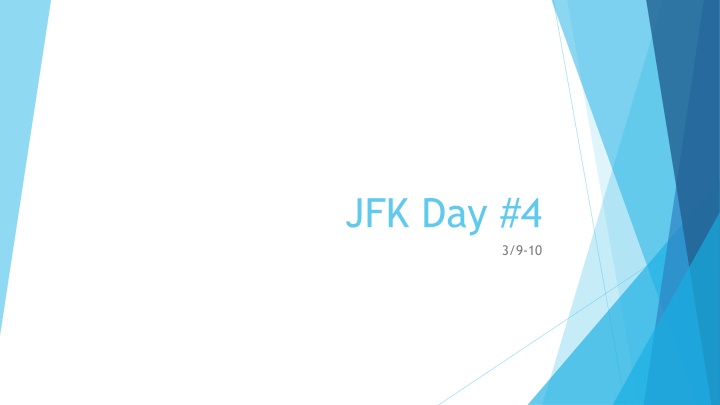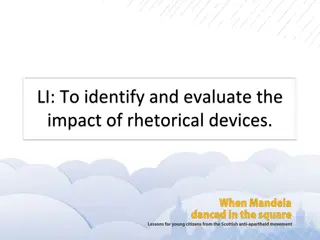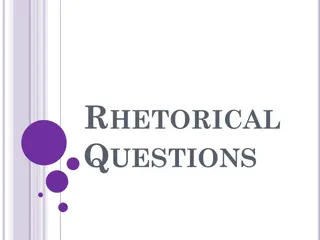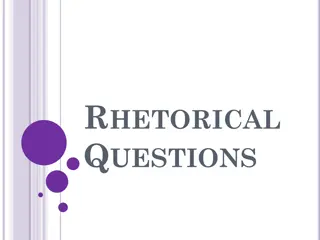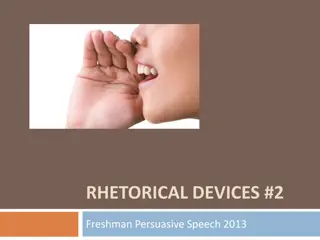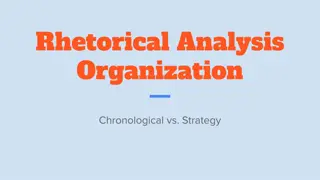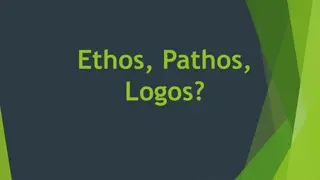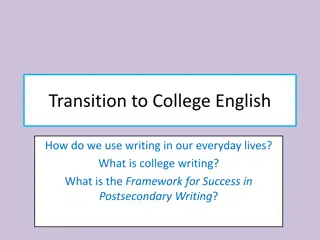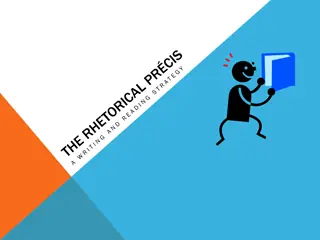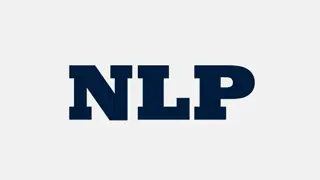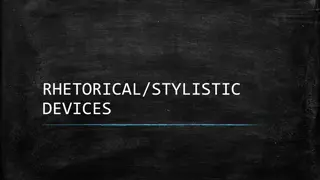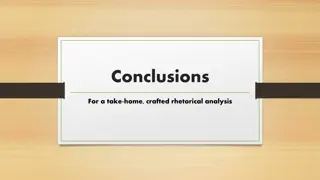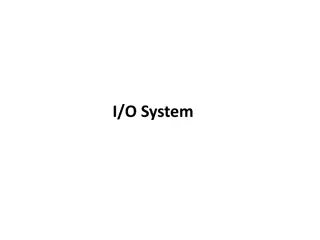Analyzing JFK's Rhetorical Devices in Inaugural Address
Explore the rhetorical devices used by JFK in his Inaugural Address through a formal academic lens. Understand the purpose, audience, claims, and counterclaims presented in the speech. Discover the impact of rhetorical devices like ethos, pathos, logos, and more on the overall message conveyed by JFK. Dive into a detailed rhetorical analysis to enhance comprehension and critical thinking skills.
Download Presentation

Please find below an Image/Link to download the presentation.
The content on the website is provided AS IS for your information and personal use only. It may not be sold, licensed, or shared on other websites without obtaining consent from the author.If you encounter any issues during the download, it is possible that the publisher has removed the file from their server.
You are allowed to download the files provided on this website for personal or commercial use, subject to the condition that they are used lawfully. All files are the property of their respective owners.
The content on the website is provided AS IS for your information and personal use only. It may not be sold, licensed, or shared on other websites without obtaining consent from the author.
E N D
Presentation Transcript
JFK Day #4 3/9-10
Welcome! Grab Your Spot and pick up a handout!
Thats What Its All About Agenda Rhetorical Analysis Graphic Organizer Learning Targets I can break down JFK s speech for the rhetorical devices used in the speech. Break down JFK s speech for the rhetorical devices used. I can communicate my understanding of the ethos, pathos, logos, and rhetorical devices used in JFK s speech in a formal academic paragraph. Rhetorical Analysis Paragraph Homework: Finish Rhetorical Analysis Paragraph
Purpose/ Sender Purpose: The goal the speaker wants to achieve. Example: Malala Yousafzai wrote her blog primarily to call attention to what she believed was an unjust situation- limitation on the educational opportunities available to women in her culture-but she also intended to criticize the regime that created such oppression.
Audience/ Receiver Audience- The listener, viewer, or reader of a text. Most texts are likely to have multiple audience. Example: Knowing his audience well, President Abraham Lincoln used a series of biblical allusions in his Second Inaugural Address to urge unity between the North and South at the end of the civil war.
Claim, Supporting Claim, Counterclaim Claim: states the argument s main idea or position. A claim differs from a topic or subject in that a claim has to be arguable. Supporting Claim: Sub-points to the claim that support the main claim. Counterclaim: An opposing argument to the one a writer is putting forward. What are JFK s claims, supporting claims, and counterclaims?
Rhetorical Devices and their Effect Example of Device Appeal: Ethos, Pathos, Logos Effect on the Speech Syntax: Parallelism, Repetition Diction: Euphemism, Hyperbole, Imagery Additional Devices: Allusion, Analogy, Juxtaposition, Irony, Metaphor, Simile
Rhetorical Analysis Paragraph Students will write a formal, academic paragraph to show a full understanding of the JFK Inaugural Address. Students will look at audience, purpose, and 2 of the 10 rhetorical devices to explore how they contribute to the claim and counter claim of the speech.
Topic Sentence This is a modified thesis statement. In _title in quotations or underlined, as appropriate_ by _first and last name of author_, the speaker makes use of several rhetorical devices including: _insert a list of devices and strategies here_ in order to further his/her claim that _insert speaker s main claim here_. In the now famous inaugural address by John F. Kennedy, the speaker makes use of several rhetorical devices including: juxtaposition and analogy in order to further his claim that people of America, and the world, need to come together as one to make the world a better place.
Analysis, Analysis, Analysis _Speaker s last name_ makes use of __first device/strategy from list_ to highlight _something about her claim__. An example of this is when he/she says, _insert textual evidence here_. This example functions as _ the device/strategy_ because _explain how the device/strategy works (you can use more than one sentence)_. This allows the speaker to _ explain how the rhetorical device develops this particular part of the speaker s claim (you can use more than one sentence)_. JFK makes use of juxtaposition to highlight humanities new power to abolish all forms of human poverty and all forms of human life (JFK). This example functions as juxtaposition because he positions the ability to solve human poverty next to the ability to end human life. This this allows the speaker to make a choice in mind of the audience to work towards a bright future or a radioactive end.
Counterclaim! _Speaker s last name_ makes use of __first device/strategy from list_ to highlight _something about her counterclaim. An example of this is when he/she says, _insert textual evidence here_. This example functions as _ the device/strategy_ because _explain how the device/strategy works (you can use more than one sentence)_. This allows the speaker to _ explain how the rhetorical device develops this particular part of the speaker s claim (you can use more than one sentence)_. JFK makes use of analogy to highlight his counterclaim that the rise of dictators should not be supported by the rest of the world. An example of this is when he mentions, in the past, those who foolishly sought power by riding the back of the tiger ended up inside (JFK). This example functions as an analogy because he shows that dictators are the ones riding the tigers and the tiger is the power itself. This shows that this new power is not something that one person can without dire consequences.
Conclusion- Wrap It Up! These two rhetorical devices work together to __the tone that is created__that __the main purpose of the speach___. These two rhetorical devices work together to create a hopeful yet warning tone that inspires and warns that American people and the world.
Rhetorical Analysis Paragraph Students will write a formal, academic paragraph to show a full understanding of the JFK Inaugural Address. Students will look at audience, purpose, and 2 of the 10 rhetorical devices to explore how they contribute to the claim and counter claim of the speech.
